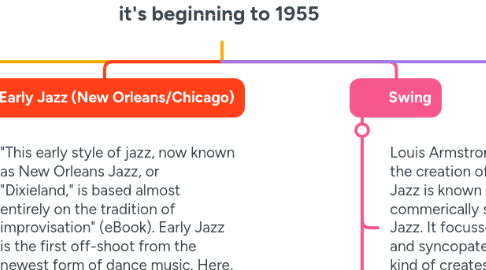
1. The Roots of Jazz
1.1. Jazz found its roots in New Orleans, Louisiana in the early 1900s. With music styles like the Blues and Ragtime, Jazz evolved into the new wave of dancing music. However, in 1917, Jazz performers were cast out of NOLA, and looked for work in other parts of the country. Places like Chicago, New York, and Los Angeles.
1.1.1. Reference
1.2. The Blues is a term used for sad music that follows a 12-bar strophic song. The chord progession always goes like this: I,I,I,I,IV,IV,I,I,V,IV,I,I or V.
1.2.1. Reference
1.3. Ragtime is different than the Blues because it is originally based on piano sheet music. The term Ragtime stems for the word "ragged" which is used to describe how the accented notes are played off-beat, making the song feel ragged.
1.3.1. Reference
1.4. Charles "Buddy" Bolden
1.4.1. Bolden was a prominent Cornet player in the early 1900s. It has been said that his listeners were adament dancers, and loved to follow his music and performances around the country. He is nicknamed the "King" of Jazz and Blues.
1.4.2. Reference
1.5. Original Dixieland Jazz Band
1.5.1. The Original Disxiland Jazz Band is known as the first band to record Jazz songs. The song, "Livery Stable Blues" was the first among many to be recorded from this group.
1.5.2. Reference
1.5.3. This is a video of them playing "Livery Stable Blues"
2. Early Jazz (New Orleans/Chicago)
2.1. "This early style of jazz, now known as New Orleans Jazz, or "Dixieland," is based almost entirely on the tradition of improvisation" (eBook). Early Jazz is the first off-shoot from the newest form of dance music. Here, the improvisation, syncopated rhythms, and repeated sections were in its infancy, and were beginning to blossom.
2.1.1. Reference
2.2. Louis Armstrong
2.2.1. Probably one of the most recognizable names on this timeline, Louis Armstrong developed his own style of jazz that includes looser sections and Swing. He was born in a lower income area of NOLA, and found himself playing the trumpet to ease his mind. After he realized his aptitude, he went on to perform with his "Hot Five" and "Hot Seven".
2.2.2. Reference
2.2.3. Watch his live performance of "La Vie En Rose"
3. Swing
3.1. Louis Armstrong is credited with the creation of Swing Jazz. Swing Jazz is known as the first commerically successful form of Jazz. It focusses on bigger bands and syncopated notes. In a way, it kind of creates an accent (like British versus Australian accents) to the notes.
3.1.1. Reference
3.2. Count Basie and his band
3.2.1. Count Basie is known as one of the world's Best bandleaders. His music has an unique fusion of Bllues and Swing Jazz that shines through his use of the bigger bands. He is also titled the "King of Swing".
3.2.1.1. Reference
3.2.2. Video of him and his band playing "One O'Clock Jump"
4. Bebop
4.1. During this time, around the 1940s, World War II had drafted many musicians. Consequently, the big-bands of Swing Jazz had trimmed their numbers to a much smaller amount. Only key players like a few wind instruments and a rhythm section. The music had also evolved once again. Charlie Parker influenced the music and it became much sharper, complex, and less dance.
4.1.1. Reference
4.2. Charlie Parker
4.2.1. Charlie Parker was a man who hailed from Kansas City and brought with him this new wave of Jazz called "Bebop". This new form of Jazz takes on a completely different focus of playing. These new songs were fast-paced, irregular, and had syncopated phrasing.
4.2.2. Video of him playing "Summertime"
